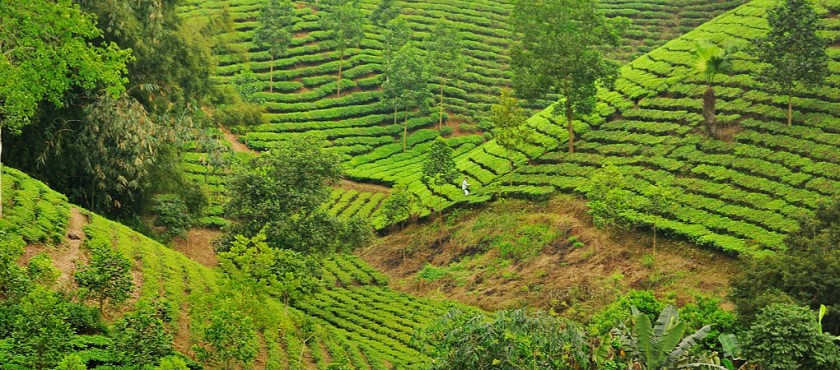Part I (Part II can be found here)
Image credit: Tea Plantation, Vietnam, by Ania/Flickr, license: CC BY-NC-ND 2.0
Written by Kuan-Ren Yun (雲冠仁), translated by Sam Robbins
During Taiwan’s urbanisation and industrial transformation of the 1960s, the total surface area of flat land used to grow tea leaves began gradually shrinking. This coincided with the rise of competition from China’s tea industry, which caused challenges for Taiwan’s tea industry. But within every crisis lies possibility, and Taiwan’s tea industry responded by orienting toward “high-quality tea leaf” production in this era. As Taiwan’s flat land had already been developed by this time, Taiwan’s tea industry started to head higher into the mountains to grow crops. It increasingly focused on producing the more technically difficult Oolong tea. All tea growing areas began promoting their special high-mountain Oolong tea varieties, such as Alishan, Lishan and Dayuling. These tea brands not only sold well domestically but were also received well internationally, and Oolong tea and Taiwan tea increasingly become interchangeable terms.
Starting in the 1990s, Taiwan’s tea industry faced another transitional era. Earthquakes and natural disasters wrecked the high-mountain tea farms and at the same time, as people’s habits began to change, so too did the number of people in Taiwan drinking fresh Oolong tea using tea leaves. What had come to replace tea leaves were tea bags or instant tea (such as bubble milk tea), which were much more convenient for consumers. This increased the demand for tea leaves to be used for making drinks (and not for direct purchase as tea leaves). As the price of labour and land in Taiwan increased, the tea industry could not meet this new and changing domestic demand, and Taiwan had to rely on imported tea leaves to make up for increased consumption.
Recently, the total amount of tea imported to Taiwan has surpassed three tonnes per year, and tea leaves from Vietnam account for 70% of all important. However, as stories of Vietnamese tea leaves failing to stand up to food safety standards due to the use of pesticides, Taiwanese consumers increasingly became wary of Vietnamese tea. In addition, the Taiwanese government has also implemented protectionist policies to help the domestic tea industry, such as requiring labels displaying tea leaves’ origins or subjecting tea imports to more stringent investigations at the border. Such developments have caused a major crisis for the Taiwanese businesspeople involved in the tea industry in Vietnam. When I travelled to Vietnam in 2016 to better understand this industry, I heard many stories of Taiwanese businesses looking to sell up and return to Taiwan.
These trends again reversed in 2017 when an endless number of bubble tea stores appeared across the streets of Hanoi. As bubble tea has taken off in Vietnam (and globally), there are now over 1500 bubble tea stores in Vietnam. When a Taiwanese TV show interviewed James C. F. Huang (黃志芳), who was serving as the director of Taiwan’s New Southbound Policy Office, he expressed his view of the potential of the bubble tea industry across Southeast Asia, and such remarks catalysed the establishment of the Taiwan bubble tea marketing alliance (台灣珍珠奶茶行銷聯盟) in Southeast.
As Vietnam was hit with a bubble tea fever, Taiwanese businesses started to set up Taiwanese bubble tea stores in Vietnam. These businesses had transitioned from producing Oolong tea leaves to be drunk directly to producing leaves for tea drinks. Now, in addition to selling tea leaves grown in Vietnam to Taiwan, they also started selling to Vietnamese businesses. When I was in Vietnam from 2016 to 2018, there was a time of immense market transformation underway that raised a very interesting question: The now-famous “Taiwanese bubble tea” had become reliant on Vietnamese tea leaves in Taiwan, and it was only after the transition to Vietnamese tea leaves was made could Taiwanese bubble tea be produced at such a scale to become a global phenomenon. Unfortunately, as Taiwanese bubble tea was taking over the world, the Taiwanese government was implementing protectionist policies restricting Vietnamese imports, which created an interesting situation that I will explore in the next piece.
Part II can be found here
Kuan-Ren Yun drinks bubble tea every day, and has thus become a VIP at his local campus bubble tea store. It was his love of bubble tea that lead him on the path to research. He now works as a high school geography teacher.
This article is the introduction to a special series of translations from 尋找台灣味 (Searching for Taiwan’s Flavour). Over the following months, Taiwan Insight will publish abridged and translated versions of each chapter from the book. Find all published articles here.

